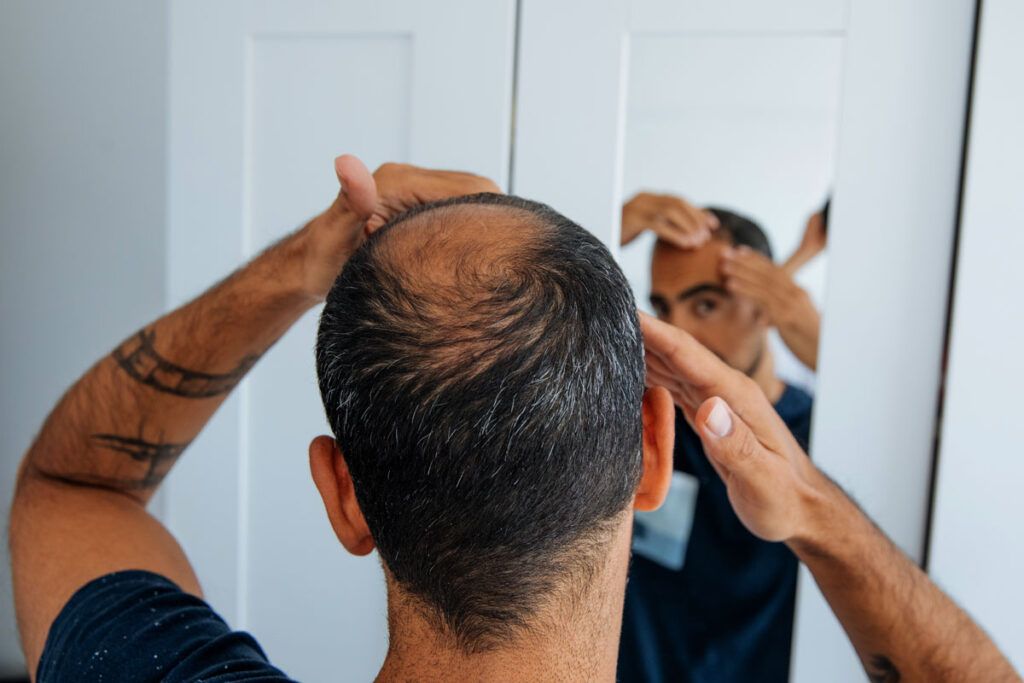Finasteride belongs to a class of medications called 5-alpha-reductase inhibitors. It reduces the effects of an enzyme called 5-alpha-reductase.
The 5-alpha-reductase enzyme converts testosterone into the sex hormone dihydrotestosterone (DHT), which may enlarge the prostate and shrink hair follicles. That’s why finasteride is approved for conditions like enlarged prostate or benign prostatic hyperplasia (BPH) and male pattern hair loss (MPHL), which are both related to the overproduction of DHT.
The finasteride package label instructs it is not for use in women or children. However, under specific circumstances, some healthcare professionals may prescribe the medication for excess facial hair growth in females.
Finasteride comes in a generic version, or you may also find it in the United States as brand names like Proscar, for enlarged prostate and hair loss, and Propecia, for male pattern baldness.
Proscar contains 5 mg finasteride, while Propecia contains 1 mg.
There is no OTC version of finasteride. Finasteride generic and brand versions are prescription-only medications.
What do you need to do to get finasteride from your doctor?

Finasteride is a prescription-only medication, so you need to talk with a healthcare professional first.
You can ask your medical professional for finasteride, but they’ll want to confirm you have symptoms of BPH or MPHL. They will evaluate your medical history, perform a physical exam, and possibly order tests to check whether finasteride is right for you. They may decide there are other more suitable options.
Some factors that a doctor might consider before prescribing finasteride may include:
- age and general health
- the severity and effects of your symptoms
- family history of prostate cancer or pattern baldness
- current medications and supplements
- allergies or sensitivities
- personal expectations and preferences
- whether you or your partner are likely to get pregnant
Finasteride use may lead to congenital abnormalities if taken or handled during pregnancy. Anyone who is pregnant or may become pregnant should avoid taking or handling finasteride tablets or coming into contact with the body fluids of a male who takes the medication. Consider discussing this with a healthcare professional for more information.
Check finasteride risks and side effects
A doctor may also discuss with you the possible finasteride side effects. According to the Proscar brand and Propecia brand labels, these may include:
- decreased libido (sex drive)
- erectile dysfunction
- ejaculation issues
- drop in blood pressure when standing up (orthostatic hypotension)
- feeling mentally and physically weak (asthenia)
- breast tenderness or enlargement
- localized or generalized rash or itching
- headaches
- dizziness
- swelling in the hands or feet (peripheral edema)
Some of the rare but serious side effects of finasteride may include:
- depression or anxiety
- allergic reactions
- liver damage
- male breast cancer
- prostate cancer
The brand medication labels note that adverse reactions from using finasteride with other drugs are unlikely. Still, it’s best to tell a doctor about any products you use before taking finasteride.
How do you get finasteride, and how much is it?
Once you have a prescription, you can fill it at a licensed pharmacy, online, or in person. You will need to get it from the pharmacist service window since it is not an over-the-counter medication.
Finasteride comes in tablet form that you take by mouth once a day. You can have it with or without food.
The cost of finasteride may vary depending on:
- your location
- dosage
- tablet quantity
- insurance coverage
- pharmacy
Generic finasteride is generally more affordable and works just as well as brand names.
The table below shows some cost estimates for finasteride at independent pharmacies both without coupons or insurance and using the Optum Perks Discount Card:
| Finasteride version | Cost without coupons or insurance (30 tablets) | Cost using Optum Perks Discount Card (30 tablets) |
|---|---|---|
| Generic | • 1 mg: up to $76 • 5 mg: up to $81 | • 1 mg: $3–$6 • 5 mg: $6–$24 |
| Propecia | • 1 mg: up to $127 | • 1 mg: $109–$115 |
| Proscar | • 5 mg: up to $188 | • 5 mg: $148–$153 |
Keep in mind that coupons and prescription discounts change regularly, so you may find more significant savings on some days than others.
You can use Optum Perks prescription discount programs even if you have a health insurance card, but you won’t be able to use both at the same time. You can show both of them to the pharmacist to check which offers more savings on finasteride.
If you need help covering the cost of medications, the free Optum Perks Discount Card could help you save up to 80% on prescription drugs. Follow the links on drug names for savings on that medication, or search for a specific drug here.
